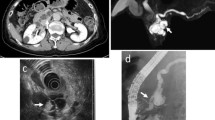Abstract
Background
International consensus guidelines for intraductal papillary mucinous neoplasms (IPMNs) were revised in 2012.
Aims
We aimed to evaluate the clinical utility of each predictor in the 2006 and 2012 guidelines and validate the diagnostic value and surgical indications.
Methods
Forty-two patients with surgically resected IPMNs were included. Each predictor was applied to evaluate its diagnostic value.
Results
The 2012 guidelines had greater accuracy for invasive carcinoma than the 2006 guidelines (64.3 vs. 31.0%). Moreover, the accuracy for high-grade dysplasia was also increased (48.6 vs. 77.1%). When the main pancreatic duct (MPD) size ≥8 mm was substituted for MPD size ≥10 mm in the 2012 guidelines, the accuracy for high-grade dysplasia was 80.0%.
Conclusions
The 2012 guidelines exhibited increased diagnostic accuracy for invasive IPMN. It is important to consider surgical resection prior to invasive carcinoma, and high-risk stigmata might be a useful diagnostic criterion. Furthermore, MPD size ≥8 mm may be predictive of high-grade dysplasia.


Similar content being viewed by others
References
Kobari M, Egawa S, Shibuya K, et al. Intraductal papillary mucinous tumors of the pancreas comprise 2 clinical subtypes: differences in clinical characteristics and surgical management. Arch Surg. 1999;134:1131–1136.
Terris B, Ponsot P, Paye F, et al. Intraductal papillary mucinous tumors of the pancreas confined to secondary ducts show less aggressive pathologic features as compared with those involving the main pancreatic duct. Am J Surg Pathol. 2000;24:1372–1377.
Sugiyama M, Izumisato Y, Abe N, et al. Predictive factors for malignancy in intraductal papillary-mucinous tumours of the pancreas. Br J Surg. 2003;90:1244–1249.
Tanaka M, Chari S, Adsay V, et al. International consensus guidelines for management of intraductal papillary mucinous neoplasms and mucinous cystic neoplasms of the pancreas. Pancreatology. 2006;6:17–32.
Goh BK, Tan DM, Ho MM, et al. Utility of the sendai consensus guidelines for branch-duct intraductal papillary mucinous neoplasms: a systematic review. J Gastrointest Surg. 2014;18:1350–1357.
Tanaka M, Fernandez-del Castillo C, Adsay V, et al. International consensus guidelines 2012 for the management of IPMN and MCN of the pancreas. Pancreatology. 2012;12:183–197.
Goh BK, Thng CH, Tan DM, et al. Evaluation of the Sendai and 2012 International Consensus Guidelines based on cross-sectional imaging findings performed for the initial triage of mucinous cystic lesions of the pancreas: a single institution experience with 114 surgically treated patients. Am J Surg. 2014;208:202–209.
Mimura T, Masuda A, Matsumoto I, et al. Predictors of malignant intraductal papillary mucinous neoplasm of the pancreas. J Clin Gastroenterol. 2010;44:e224–e229.
Kim KW, Park SH, Pyo J, et al. Imaging features to distinguish malignant and benign branch-duct type intraductal papillary mucinous neoplasms of the pancreas: a meta-analysis. Ann Surg. 2014;259:72–81.
Roch AM, Ceppa EP, DeWitt JM, et al. International Consensus Guidelines parameters for the prediction of malignancy in intraductal papillary mucinous neoplasm are not properly weighted and are not cumulative. HPB (Oxford). 2014;16:929–935.
Jang JY, Park T, Lee S, et al. Validation of international consensus guidelines for the resection of branch duct-type intraductal papillary mucinous neoplasms. Br J Surg. 2014;101:686–692.
Goh BK, Lin Z, Tan DM, et al. Evaluation of the Fukuoka Consensus Guidelines for intraductal papillary mucinous neoplasms of the pancreas: results from a systematic review of 1,382 surgically resected patients. Surgery. 2015;158:1192–1202.
Yamada S, Fujii T, Murotani K, et al. Comparison of the international consensus guidelines for predicting malignancy in intraductal papillary mucinous neoplasms. Surgery. 2016;159:878–884.
Bosman FT, Carneiro F, Hruban RH, Theise ND. WHO Classification of Tumours of the Digestive System. 4th ed. Lyon: International Agency for Research on Cancer; 2010.
Maitra A, Fukushima N, Takaori K, Hruban RH. Precursors to invasive pancreatic cancer. Adv Anat Pathol. 2005;12:81–91.
Goh BK, Tan YM, Cheow PC, et al. Cystic lesions of the pancreas: an appraisal of an aggressive resectional policy adopted at a single institution during 15 years. Am J Surg. 2006;192:148–154.
Anand N, Sampath K, Wu BU. Cyst features and risk of malignancy in intraductal papillary mucinous neoplasms of the pancreas: a meta-analysis. Clin Gastroenterol Hepatol. 2013;11:913–921. (quiz e59-60).
Poultsides GA, Reddy S, Cameron JL, et al. Histopathologic basis for the favorable survival after resection of intraductal papillary mucinous neoplasm-associated invasive adenocarcinoma of the pancreas. Ann Surg. 2010;251:470–476.
Kang MJ, Jang JY, Lee S, et al. Clinicopathological meaning of size of main-duct dilatation in intraductal papillary mucinous neoplasm of pancreas: proposal of a simplified morphological classification based on the investigation on the size of main pancreatic duct. World J Surg. 2015;39:2006–2013.
Tanaka M. International consensus on the management of intraductal papillary mucinous neoplasm of the pancreas. Ann Transl Med. 2015;3:286.
Acknowledgments
We thank Ms. Yuki Saka and Tomoko Ubukata for their excellent assistance.
Author information
Authors and Affiliations
Corresponding author
Ethics declarations
Conflict of interest
There was no significant financial support for this work that could have influenced its outcome.
Ethical approval
The study was approved by the Ethics Committee of the hospital, and all clinical samples were used in accordance with institutional guidelines and the Declaration of Helsinki after obtaining signed informed consent from all participants.
Electronic supplementary material
Below is the link to the electronic supplementary material.
Rights and permissions
About this article
Cite this article
Tsukagoshi, M., Araki, K., Saito, F. et al. Evaluation of the International Consensus Guidelines for the Surgical Resection of Intraductal Papillary Mucinous Neoplasms. Dig Dis Sci 63, 860–867 (2018). https://doi.org/10.1007/s10620-017-4667-y
Received:
Accepted:
Published:
Issue Date:
DOI: https://doi.org/10.1007/s10620-017-4667-y




